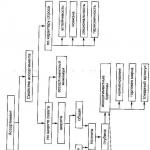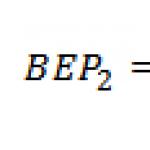Quantitative restrictions on imports and exports (quantitative control measures). III. Export bans and quantitative restrictions What are the export restrictions
Export Restriction Agreement- a tool for regulating international trade and economic activity. An agreement is reached between the exporting country and the importing country. An agreement on a restriction leads to a decrease in the volume of export of a certain group of goods from the exporting country, which is achieved by setting a quota. The initiative to adopt such an agreement usually comes from the importer.
The need to use an export restriction agreement is explained by the fact that other methods of regulating the economic and trade activities of countries are under the control of the World Trade Organization. The adoption of the agreement refers to political methods of influence and is not within the competence of the WTO.
One of the possible negative consequences of the adoption of an export restriction agreement is the loss of markets for goods. In this case, the exporter can improve the situation by changing the assortment or by placing its own branches in the territory of the importing country.
Procedure for negotiating an export restriction agreement
Restrictions on the import of specific groups of goods can be introduced in the following ways:
- through the adoption of a formal agreement by the governments of the two states;
- through the adoption of an informal agreement between the producer-exporter and the consumer-importer, reached with the support of the government of the exporting party;
- by reaching an agreement on limiting a group of countries.
The procedure for adopting export restriction agreements is regulated by the "Procedure for Quotas and Licensing" adopted in 1995.
An export restriction agreement may be adopted on a permanent or temporary basis. The possibility of extending the agreement, if it is temporary, is discussed between the states after the expiration of the term additionally.
Reasons for adopting an export restriction agreement
The reasons for accepting the agreement may be as follows:
- decrease in the volume of production of certain groups of goods in the exporting country;
- a decrease in the volume of extraction of a resource that acts as a commodity exported from the country;
- no shortage of certain goods in the importing country;
- substitution of imported goods with similar ones of own production;
- oversaturation of the market with goods in the importing country;
- the imported goods jeopardize the internal security of the importing state, as well as the health and property of its citizens;
- regulation of domestic consumption of agricultural goods;
- changing international economic obligations to other countries;
- thereby preserving the cultural heritage of the country;
- protection of the internal economic interests of the state.
Unlike other measures to regulate exports, the adoption of an agreement on limiting practically does not affect the citizens of the state, since it does not imply an increase in the tax rate due to an increase in customs duties and import/export tariffs. Accordingly, such an agreement does not negatively affect pricing.
In conditions when the customs-tariff policy cannot fulfill its tasks with a sufficient degree of efficiency, the question of applying additional measures of foreign trade policy has been put on the agenda. Quantitative restrictions proved to be the most effective under these conditions.
Methods of quantitative regulation of foreign trade or permissive regimes, with the help of which the administrative influence of the state on foreign economic relations is carried out, are applied in waves: in the phases of the aggravation of the economic situation on the world market, the intervention of the state sharply increases, in the phases of high market conditions, a noticeable relief of the permitting regime occurs.
Quantitative restrictions on imports and exports are a direct administrative form of state regulation of foreign trade turnover. The main purpose of their application is to protect the positions of national producers in cases where other trade and political means are not effective enough. Intertwined with this task is another, no less important task - maintaining the prices of goods, and, consequently, the profits of producers. Quantitative import restrictions are used to oust competitors from the domestic market. The role of quantitative restrictions is also great as an instrument of economic pressure on other countries in order to bargain for concessions in the competition and in trade negotiations.
Measures of quantitative control of import and export operations are primarily quoting and licensing. Quantitative restrictions - quotas (by physical volume or value), as well as licensing (the requirement to obtain special permits for the supply of certain goods, and sometimes to or from certain countries) are traditional non-tariff measures for regulating imports and exports. Their purpose is to restrict the import or export of any particular commodity, either to (or from) all sources or to (or from) specific countries. These measures are often linked, as licensing is used as a quota allocation mechanism by issuing licenses to individual importers before the quota is exhausted.
2.1. Licensing
Licensing is the most common form of NTOs, accounting for nearly half of their applications. At the same time, more than 80% of them affect trade industrial goods. According to the practice established in Russia, the introduction of quantitative restrictions, as a rule, is accompanied by licensing.
Modern licensing is a restriction in the form of obtaining the right or permission from authorized state bodies to carry out specific export and / or import operations. There are two forms of licensing:
automatic;
non-automatic.
Automatic Licensing has the peculiarity that the importer (exporter), applying for an import (export) permit, automatically receives a permit for the import (export) of goods, provided that he has not received an official refusal.
Automatic import licensing is subject to the following conditions:
a) automatic import licensing procedures should not be applied in a manner that restricts imports subject to automatic licensing;
b) automatic import licensing may be maintained as long as the circumstances that give rise to its introduction prevail and the underlying administrative objectives cannot be achieved in a more appropriate manner.
An example of automatic licensing is the resolution of the Government of the Russian Federation on the implementation of the Agreement between Russian Federation and the European Community (EC) on trade in textiles. The Ministry of Trade of the Russian Federation during the period of this agreement was instructed to automatically issue permits for the export of textile goods and clothing to the EU countries to Russian participants in foreign trade activities.
Thus, if the automatic licensing regime is introduced, the formalities for obtaining a license are greatly simplified, but the legal mechanism continues to operate, allowing the state to exercise control over foreign trade operations. With automatic licensing, the state retains the right to replace the liberal regime with a tougher one at any time. However, automatic licensing is the preferred type of restrictive policy, so the GATT decided to encourage member countries that practice quantitative restrictions to switch to this type of licensing whenever possible.
Since with automatic licensing, approval of the application is given in all cases (subject to the above conditions), i.e. a license is issued to all persons who have applied for its issuance, such a licensing procedure is declarative procedure for issuing licenses. In contrast, there is permissive procedure for issuing licenses. Permissive licenses are issued depending on the decision of the relevant state body (in other words, the issuance of a license may be refused). It's a procedure non-automatic licensing.
Manual Licensing (Licensing)- Permissive procedure for the import or export of goods after receiving a special (written, in the form of a special document) permission from the authorized state body.
Licensing in international trade has great flexibility and variety. Currently, the most commonly used types of licenses are:
general,
individual.
General license- This is a permanent permit that grants the right to any person or company to import the goods listed in it without any restrictions on quantity or value during the entire period of validity of the license.
A general import license authorizes the importation of the following goods:
a) either from certain countries listed in it;
b) either from any country. In this case it is called global, or open, general license.
Due to the fact that at present the import (export) of a large number of goods is allowed under a general license, listing them would turn it into a cumbersome document. Therefore, another way has been chosen: if necessary, only those goods of a given group, the import or export of which is prohibited, are indicated in the general license. At the same time, it is indicated that all other goods can be freely imported (exported) on the basis of a general license.
General licenses and related product lists are published in official publications.
Individual (single) license- this is a one-time permit for one trade operation (export or import of goods) with a specific type of product (sometimes two or three types, but for the same product group).
It is issued by the competent state authority supervising foreign trade upon the application of the national exporting or importing firm. The license is nominal, i.e. it cannot be transferred to another exporter or importer.
An individual license regulates all the most important aspects of a foreign trade transaction. It states:
amount;
the cost of goods allowed for import (export);
country of origin of the goods;
exporting company (importer);
license validity period.
A single license is issued for the purchase of goods included in the import control list, or goods originating from countries with which trade is controlled. An individual license is a very strict form of quantitative restrictions. Often, in addition, the granting of a license is conditional on obtaining foreign exchange permits.
The form of a one-time individual permit is a license issued at the choice of the licensing state body, the so-called discrete license. In some cases there are open individual licenses. Their difference from the usual ones is that a company that has received such a license can import the goods specified in it without quantity restrictions.
Licensing generally performs two functions:
reducing the access of foreign goods to the domestic market (or the export of goods abroad);
facilitating control over the movement of goods across the customs border without limiting the number of imported or exported goods.
In the first case the economic result of licensing differs little from the establishment of quotas (quotas). In practice, licensing is often used in conjunction with quantitative restrictions and is a tool to ensure compliance with export and import quotas (licenses are issued until the volume of quotas is used up). The function of restricting import or export can only be performed by a permissive license.
In the second case the purpose of the licensing procedure is to strengthen state control over the course of trade. Such control can be expressed in the form of limiting the number of persons involved in foreign trade operations. It is accompanied by the use of permissive general, less often one-time licenses. Or we can talk about the desire of the state to obtain more complete information about enterprises engaged in foreign trade operations with a particular product, and the size of the turnover. In this case, the declarative form of licensing is used. Such licensing is often referred to as monitoring .
In some cases, licensing is introduced in order to ensure that quality standards are met when a product is delivered. Basically, this is done in relation to export goods in order to maintain their high reputation and competitiveness in the world market.
The licensing procedure is often applied to so-called specific goods. These include goods that have historical, artistic or cultural value, or significant environmental value. As well as goods that are essential from the point of view of personal or public security and the political interests of the country (weapons, poisons, drugs, medicines, etc.). In this case, permissive licensing applies.
When organizing the issuance of licenses, one has to face a number of serious problems. Among them: high administrative costs; high probability of obtaining a license by not the most efficient exporters and importers and the use of biased criteria in the selection of firms obtaining a license; high risk of abuse. The disadvantage of licensing is also that, unlike customs duties, this regulatory tool cannot be considered as significant source budget revenues.
In some cases, it is practiced to issue licenses depending on the indicators of export activity or the amount of purchases of similar goods in the domestic market. Sometimes, due to the difficult state of the balance of payments, in order to reduce foreign exchange costs, import licenses are issued only for barter transactions or depending on the availability of foreign exchange funds of a given firm abroad.
In Russia, automatic licensing measures have not yet been developed. Non-automatic licensing is carried out in order to ensure control over import and export specific goods(wild animals, wild plants, bones of fossil animals, ivory, horns, hooves, corals, collection materials on mineralogy and paleontology, medicinal raw materials of plant and animal origin, information about subsoil areas and deposits of fuel and energy and mineral raw materials, semiprecious stones and products from them). Licenses are required to import chemical plant protection products, as well as industrial waste. In order to ensure the interests of national and international security, trade in military and dual-use goods and technologies is subject to license control. In Russia, licensing in order to comply with foreign trade quotas was associated with quantitative restrictions not on imports, but on exports, due to the shortage of the domestic market in the early 1990s. Export quotas were abolished in 1995 in connection with the adoption of the Federal Law "On State Regulation of Foreign Trade Activity", which prohibits quantitative restrictions on exports and imports.
An integral part of licensing is quoting.
Contingenting- the establishment by the state of centralized control over export and import by limiting the range of goods, i.e. restriction of import of foreign (export of national) goods by a certain quantity, volume or amount for a specified period of time ( setting quantitative or value quotas).
Although contingentation affects a relatively small part of the product range, the significance of contingents (quotas) in trade is quite noticeable, since the number of contingent goods includes, as a rule, the most important raw materials and food products, textiles, ferrous and non-ferrous metals, and medicines. Product allocation has a significant impact on the volume and structure foreign trade, as well as on prices, ensuring their growth and thereby protecting those national companies that produce or sell the product that is the object of the restriction.
Introduction
Export is an integral part of any economy. Net exports should be understood as the excess of exports of consumer goods over imports. Most countries strive for their exports to outweigh their imports. However, on a global scale, the sum of excesses of exports over imports in some countries is equal to the sum of excesses of imports over exports in others.
This desire, first of all, is explained by the desire of countries not to increase external debt: if net exports are positive, then this country becomes a creditor relative to other countries, if negative, this country has an external debt.
The predominance of net exports or imports in long term in principle, it is impossible, since no one will dare to continuously trade in debt for a long time. The use of gold reserves in this case should be considered as a barter exchange, which is tantamount to selling gold as an export commodity.
The transformation of a national currency into a convertible international one is possible for any rich country that freely trades with many countries of the world and does not create unnecessary customs barriers to protect its producers. In this case, the rest of the countries in trade with each other use the currency of rich countries.
Net exports arise in conditions of successful competition of a given country in foreign markets and, of course, are accompanied by some expansion of markets for goods for industrial and personal consumption (sometimes due to dumping prices), which is associated with additional net investment benefits.
With negative net exports (excess of imports over exports), which arose for the first time, an additional volume of consumer goods enters the domestic market in this period, for the purchase of which the consumption sector spends part of its income. This means that only the remaining part of her income will be spent on the entire volume of consumer goods produced during this period in the production sphere (and fully paid for in the consumption sphere). This leads to deflation.
The purpose of my work is to analyze the state of modern Russian exports.
The main tasks are:
Define key concepts export trade;
Analyze the current state of the export situation in the country;
And assess further prospects for the development of exports.
Export
Basic concepts
The word "export" comes from the Latin "exporto", which literally means "send goods and services from the port of the country" Encyclopedia "Wikipedia" [ electronic resource]: http://ru.wikipedia.org/wiki/Export. In other words, export is understood as the export abroad of goods, technologies, services sold to a foreign buyer or intended for sale in a foreign market. Export is the main element of the trade sphere: as a rule, the word "export" means paid export, i.e. sale in order to obtain currency, spent, in particular, on the import of goods and services necessary for the country. The equivalent concept of export is import.
The main rule that works in exports says that the “cheaper” the ruble is relative to other currencies, the more profitable exports and the more unprofitable imports. Therefore, the task of the state is to maintain the optimal ratio between them, focusing on the economic situation and the needs of the country.
Depending on the type of product intended for sale on the foreign market, there are two types of export: visible and invisible. "Visible export" refers to the export of goods from the country, "invisible" - services. "Invisible export" includes foreign investments, tourism, insurance, consulting support for foreign partners, patent and licensing and other activities other than commodity exports Lopatnikov L. And . Dictionary of Economics and Mathematics: Dictionary of Modern Economics. -- 5th ed., revised. and additional - M.: Delo, 2003. - 520 p.
According to international foreign practice, commodity exports, in turn, are also divided into several types depending on the origin and destination of goods:
Export finished products fully meeting the requirements of the buyer;
Export of finished products with pre-sale refinement in the country of the buyer;
Export of goods (raw materials or semi-finished products) for processing abroad under customs control followed by a return
Re-export, which refers to the export from the country of goods previously imported into it for resale to other countries. Re-export can be carried out both in relation to goods in an unchanged form, and after their insignificant external processing - cleaning, sorting, repacking. Most often, the subject of re-export is six, leather, rubber, non-ferrous metals, food flavoring products, etc.;
Temporary export abroad with subsequent return of domestic goods to exhibitions, fairs, auctions, etc.;
Export of foreign goods temporarily imported to exhibitions, fairs, auctions, etc.;
Intra-company deliveries - export of products in the order of direct industrial relations;
Export of products in the order of direct industrial relations of enterprises V. V. Semenikhin: Export and import of goods, services, intellectual property - Eksmo, 2009.-38s ..
Export restrictions
The export of goods takes place with the participation of the customs authorities, both in the exporting country and in the importing country. And despite the fact that the emergence of online retailers has led to a significant reduction in the importance of customs barriers in many countries due to the low level of individual value of the goods offered, even the export of these low-cost goods is subject to legal restrictions imposed by the country of export.
Export restrictions refers to restrictions on the export of goods to a certain country by the government. N. N. Shishkoedova. Export and import: Accounting, taxation, legal aspect- ROSBUKh, GrossMedia, 2011 - 169s. Moreover, the restriction can be a quantitative or total ban.
Such restrictions may be imposed in the following cases:
Shortage of goods in the domestic market;
Necessities anti-dumping measures to protect the domestic market;
government boycott of the country;
The need to limit the spread of military or dual technologies.
In Russia, control and introduction of export restrictions is carried out by the Federal Service for Technical and Export Control (FSTEC of Russia), which, being a federal executive body, implements state policy, in particular with regard to exports, and performs control functions.
With regard to export, the main powers of this service are:
Carrying out export control in accordance with the legislation of the Russian Federation and orders of the Ministry of Defense;
Development of a list of goods (works, services), information and results of intellectual activity subject to export control;
Organization and conduct of state expertise of foreign economic transactions in relation to export products that can be used in the creation of weapons of mass destruction, their delivery vehicles and other types of weapons and military equipment;
export merchandise foreign trade
Organization and issuance, in accordance with the legislation, of state accreditation to organizations that have created in-house export control programs;
Participation in the preparation of proposals for the introduction of restrictions and (or) a ban on the export of products, based on the national interests and international obligations of the Russian Federation.





